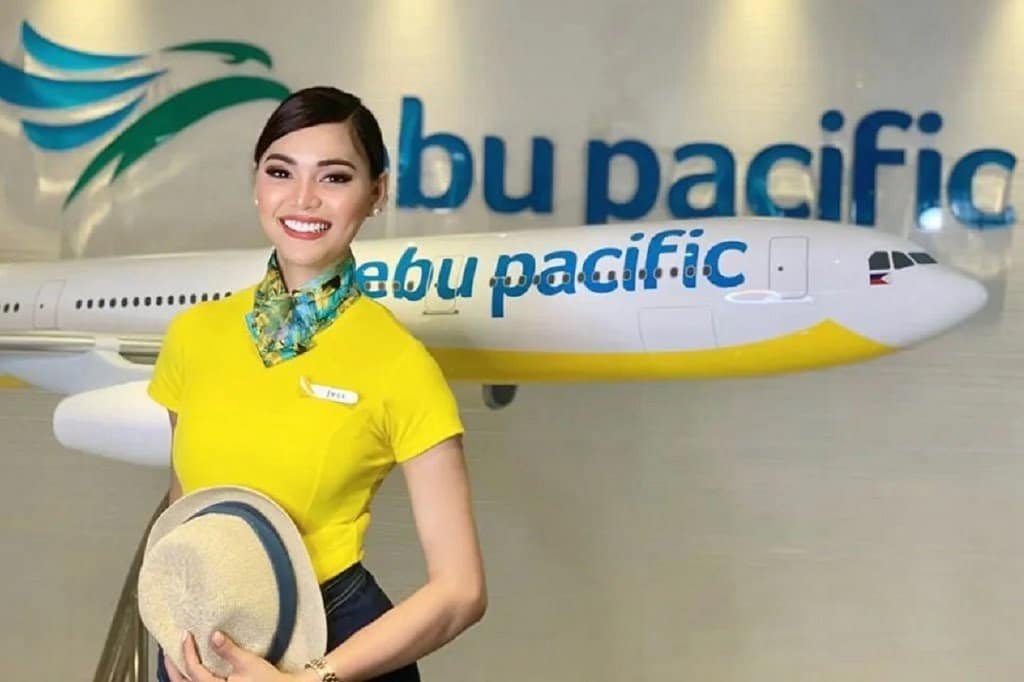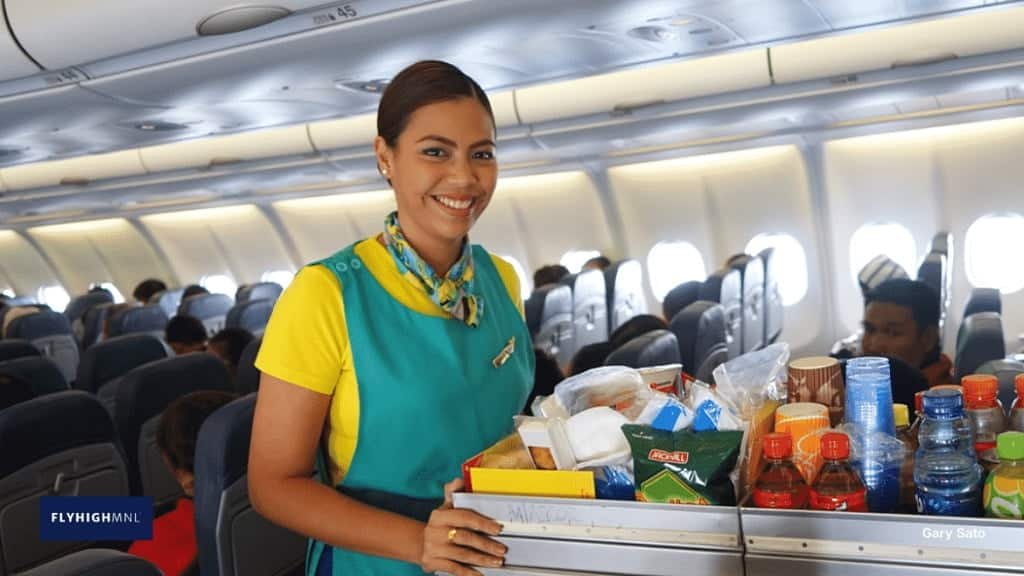Cebu Pacific Air is the leading airline in the Philippines, boasting over 200 planes in its fleet. For seven consecutive years, it’s been acknowledged among the World’s Top 100 Airlines by Skytrax and has won the “Best Low-Cost Airline” title three times. The airline embarked on its maiden flight from Manila to Cebu in 1996. Since launching its first international route to Hong Kong in 2001 and its inaugural low-cost long-haul trip to Dubai in 2013, the company’s mission has been to serve Filipino communities wherever they are.
Joining as a Cebu Pacific Flight Attendant, you’ll be immersed in various engaging tasks. On a regular day, you’ll cater to passengers by providing meals and drinks, assisting with their baggage, briefing them on safety measures, answering flight-related inquiries, ensuring all emergency tools are functional, helping during onboard crises like health incidents or fires, and keeping your area hygienic. If you’re keen on being part of this esteemed Filipino airline, here’s the information you’ll need.
Brief History of Cebu Pacific
Cebu Pacific, officially known as Cebu Air, Inc., is a Philippine low-cost airline founded in 1988 but commenced operations in 1996. Originating from its hub in Manila, the airline’s maiden journey was a domestic flight to Cebu. Over the years, Cebu Pacific has significantly expanded its fleet and destinations, pioneering “budget travel” in the Philippines.
The airline marked a milestone by introducing its first international route to Hong Kong in 2001. In subsequent years, it continued its expansion, launching its first low-cost long-haul flight to Dubai in 2013. Known for its innovative approaches to air travel, Cebu Pacific has secured its position as a major player in the aviation industry of the Philippines.
Roles and Responsibilities of Flight Attendant
Passenger Safety: A flight’s smooth operation isn’t just up to the pilots. Flight attendants play a pivotal role in ensuring passenger safety. They give safety briefings before takeoff, demonstrate the use of safety equipment, and are vigilant in ensuring passengers comply with all safety regulations throughout the flight.
Customer Service: Being confined in an aircraft for hours can be daunting for passengers. Flight attendants make this experience pleasant. They attend to passengers’ needs, from providing meals to helping with seat adjustments. They also manage special requests, such as dietary needs, and address any complaints or concerns that might arise during the flight.
Communication: Flight attendants are the bridge between the cockpit and the cabin. They interact with pilots, staying updated on flight details which they relay to passengers. Their ability to communicate effectively and calmly, especially during turbulent situations, is paramount.
First Aid: Despite all precautions, medical emergencies can occur mid-flight. Flight attendants are trained in basic first aid and can administer necessary care. Whether it’s a minor ailment or a more severe situation, their swift actions can make all the difference.
Related: Philippine Airlines Flight Attendant
Requirements to Become a Cebu Pacific Flight Attendant

Educational Background:
Cebu Pacific typically requires their flight attendants to possess at least a bachelor’s degree. The degree doesn’t necessarily have to be aviation-specific, but having one in hospitality, communication, or tourism can be advantageous.
Physical Requirements:
- Height: While specific height requirements can vary, they generally range from 5’3″ for females and 5’7″ for males.
- Weight: Proportionate to height.
- Vision: Good eyesight is essential, though wearing glasses or contacts is usually acceptable.
Language Proficiency:
Being fluent in English is a must since it’s the universal aviation language. Additionally, knowing other languages, especially local dialects, can be beneficial for serving diverse passengers.
Personality and Skills:
- Customer Service Skills: The ability to attend to passengers with patience and politeness.
- Patience: Handling different passengers, from the cooperative to the challenging.
- Ability to Handle Emergencies: Staying calm and efficient in unforeseen situations.
How to Apply for the Cebu Pacific Flight Attendant Job?
To pursue a cabin crew role with Cebu Pacific, you can initiate your application via their official Careers Page. Visit this link to get started: https://jgsummit.darwinbox.com/ms/candidate/a610f788ec3e0b/careers.
- Navigate to Cebu Pacific’s Careers Page.
- Look for the listing titled “Cabin Crew” or a similar role.
- Hit the “Apply” button, which will prompt you to set up an account.
- Complete the application process as guided.
- Once done, submit your application. Afterwards, await feedback from the Cebu Pacific recruitment team.
Related Read: Southwest Airlines Flight Attendants
Training and Development of Cebu Pacific Flight Attendant
Once selected, aspiring flight attendants undergo a rigorous training program, ensuring they are equipped with the skills necessary for the job.
Safety Training:
Here, flight attendants learn everything from the basics of flight safety to emergency evacuations, ensuring the well-being of passengers.
Customer Service Training:
A crucial part of a flight attendant’s role is ensuring passenger comfort. This training focuses on addressing passenger needs, handling complaints, and more.
Emergency Procedures and Drills:
Simulated emergencies prepare flight attendants for real-life scenarios, from minor medical situations to full-scale evacuations.
Language and Communication Skills Enhancement:
With passengers coming from all over the world, effective communication is key. This training focuses on enhancing language skills and improving overall communication with passengers and crew.
Continuous Development and Refreshers:
The aviation world is always evolving. Regular refresher courses ensure flight attendants are always up-to-date with the latest in safety protocols and customer service.
Salary and Benefits of a Cebu Pacific Flight Attendant
Flight attendants serve an essential role in delivering customer service to airline passengers and ensuring their safety during flights, which can include responding to emergencies. The following figures are approximate:
Salary Breakdown:
A Cebu Pacific flight attendant’s base pay ranges between PHP 14,000 and 16,000 monthly, with potential increases based on performance each year. There’s also an hourly Flying Time Pay, typically at PHP 350. Given that flight attendants often fly between 70 and 90 hours monthly (capped at 1,000 hours annually), this can amount to an extra PHP 24,500 per month.
Additional Financial Incentives:
Cebu Pacific offers a competitive remuneration package for its flight attendants, complemented by:
- Transportation allowances.
- Standby compensation for field reserve or airport wait times.
- Meal subsidies.
- Commissions on sales of merchandise or onboard food.
- Layover per diems, approximately USD 50 nightly.
- A 13th-month bonus.
- An annual bonus linked to company profit-sharing.
Additional Benefits:
- A retirement plan.
- Comprehensive medical coverage and life insurance.
Travel-Related Perks:
- Layovers typically involve 1 to 3-night stays overseas with allowances.
- Entitlement to unlimited local flights and six international or extended journeys annually (exclusive of terminal charges or travel taxes).
- Six round-trip flights annually for family members, although these are of lower booking priority.
Read More: Flight Attendant Salary
The Daily Life of a Cebu Pacific Flight Attendant

Pre-flight Procedures and Briefings:
Before every flight, flight attendants attend briefings where they receive information about the flight’s specifics – the number of passengers, any special requirements, and more. They also review safety procedures and discuss their respective roles and responsibilities for the flight.
In-flight Tasks and Responsibilities:
Once onboard, flight attendants prepare the aircraft for boarding, greet passengers, and assist with seating. During the flight, they serve meals, attend to passenger needs, handle any disruptions, and ensure everyone’s safety and comfort.
Layovers and Rest Periods:
Depending on the flight route, attendants might have layovers in various cities. These can range from just a few hours to a couple of days, allowing them to rest, explore, and recharge before the next flight.
Working Hours and Scheduling:
Flight attendant schedules can be erratic. They might work on long-haul flights for several days in a row followed by a few days off. Rosters are typically planned monthly, but changes can occur based on operational needs.
Challenges and Rewards
Physical Demands:
Frequent Flying: Flight attendants can often be in the air daily, which can take a toll on the body.
Varying Schedules: The erratic hours can disrupt normal sleep patterns and personal life.
Emotional Challenges:
Handling Difficult Passengers: From anxious fliers to unruly ones, flight attendants have to manage a range of passenger personalities.
Emergencies: Although rare, flight attendants are trained to handle emergencies, which can be emotionally taxing.
Rewards:
Traveling: One of the perks of the job is exploring different places on layovers.
Meeting New People: Every flight brings a new set of passengers, making each day unique.
Airline Benefits: Many airlines, including Cebu Pacific, offer discounted or free flights to their employees.
Read Also: Norse Atlantic Airways Reviews
Comparison with Other Airlines
How Cebu Pacific Differs from Other Major Airlines:
Cebu Pacific, as a leading low-cost carrier in the Philippines, has a distinct service model focusing on affordability and efficiency. Flight attendants might find that there’s a stronger emphasis on high-turnover flights and on-time performance.
Benefits, Pay, and Perks Comparison:
While the exact numbers can vary based on seniority and route, Cebu Pacific offers competitive pay and benefits in line with other major carriers. However, unlike full-service airlines, some amenities might be tailored to the low-cost model, which can be reflected in the perks and additional allowances provided.
Tips on How to Land a Flight Attendant Job
Securing a flight attendant position can be challenging, especially for industry newcomers. Nonetheless, there are strategies to enhance your chances:
- Leverage Networking: Often, jobs are secured through connections. Cultivate relationships with industry professionals and establish a reputation as a diligent and committed individual.
- Stay Updated on Vacancies: Regularly monitor airline websites and their social media platforms for job postings. This proactive approach ensures you won’t miss out on emerging opportunities.
- Educate Yourself: Familiarize yourself with the aviation sector before applying. This knowledge provides insights into what’s anticipated in different roles, avoiding unexpected challenges later.
- Gain Relevant Experience: Consider positions within the aviation field or travel agencies. Such experience can be instrumental in advancing your career.
- Explore Training Opportunities: Investigate the training courses offered by airlines. This not only provides a glimpse into their work culture but also helps set clear expectations for potential roles, avoiding unforeseen issues down the line.
Conclusion
If you’re interested in a career as a Cebu Pacific Flight Attendant, kindly adhere to the provided instructions and recommendations. Cabin Crew members play a vital role in any airline, necessitating that you meet the necessary qualifications for these positions.
These insights encompass valuable advice, the application procedure, compensation, perks, and additional particulars regarding this profession in the Philippines. We trust that you have found this manual beneficial as you embark on your path to becoming a part of this airline’s crew.















